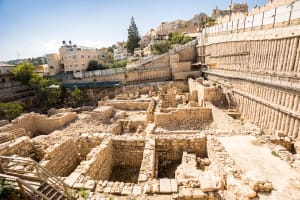Evidence for the historical site of the Oaks of Mamre
Archaeologist sees Khirbet Ramat Khalil as vivid proof of the Bible's accuracy

Alonei Mamre (The Oaks of Mamre), also known as Khirbet Ramat Khalil, is an archaeological marvel located two kilometers northwest of Hebron, in the Palestinian-controlled territories of the Judea region (West Bank).
This site, identified as the biblical residence of Abraham, carries a legacy steeped in history and religious significance. It is believed that within its grounds once flourished an oak grove, situated in the estate of a man named Mamre, an ally of the biblical patriarch Abraham during his legendary war against the eastern kings.

Unearthed by a German archaeologist in the early 20th century, Mamre's layers of buildings span different eras, from the Byzantine to late and early Roman Age, back to the Iron Age, and even the Bronze Age, reinforcing its significance for biblical narratives.
While some scholars, like the late Prof. Benjamin Mazar, cast doubts on Ramat el-Khalil's association with Alonei-Mamre, citing its relative distance from Hebron and perceived lack of major pre-Herodian findings, others expressed that early remnants from the Bronze and Iron Ages discovered here validate its authenticity as the legendary Oaks of Mamre.

Today, the remnants of Mamre offer a glimpse into its illustrious past. Archaeological excavations have revealed a square structure interpreted by some, including the archaeologist Joel Kramer, to be a Bronze Age structure and either the altar of Abraham or a reconstruction of it.
Additionally, two Iron Age square buildings located at the site's entrance but outside of a later Herodian enclosure, probably part of an ancient gate, give a hint that the site was enclosed and considered sacred during the Kingdoms of Israel and Judah.
Joel Kramer is an archaeologist living currently in Jordan and specializes in Biblical archaeological sites. He runs a very successful YouTube channel where he conveys high-quality scientific content to the general public.
In his best-selling book, "Where God Came Down: The Archaeological Evidence," Kramer explores the alignment between archaeology and scripture, using the Bible as a guide to examine findings at ten biblical sites. This book is ideal for the erudite Christian interested in learning about the accuracy of the Bible proven by archaeology.
While conflicting views and interpretations persisted until recently regarding the dating of the earliest remnants of Khirbet Ramat Khalil, most scholars now date a Roman-period Herodian wall to the 1st century B.C or A.D.
The wall dominated the landscape and is reminiscent of similar structures built in Herodian times above the Cave of the Patriarchs in Hebron and the Temple Mount in Jerusalem.
Subsequent findings point to a Roman-era water channel inside of the enclosure and leading to the outside, interpreted by Kramer as part of the pagan cult surrounding a trade fair that took place at the site. Later remnants, including those of a Byzantine church and a well-named "Be'er Abraham," speak to Mamre's evolution as a major trading center, as evidenced by numerous coins unearthed in past excavations. Despite the site being surrounded by Palestinian residential buildings since 2010, its archaeological significance remains undiminished.
During the late Roman period, Alonei Mamre occupied a pivotal position at a significant crossroads, hosting one of the prominent fairs in ancient Israel. The fair, known as "the Botnah descent," was a place of reverence but also deemed an idolatrous site by the Jewish sages, leading to its prohibition of trade. Despite such concerns, the fair persisted even after the Temple's destruction in 70 A.D., bearing witness to historical upheavals like the Bar Kokhba Revolt.
After the Herodian structure was destroyed by Simon bar Kokhba's army, Roman Emperor Hadrian ordered that it be rebuilt and revived the fair, which was significant because of its strategic location and made it a transport and communications hub for the southern Judean mountains.
Emperor Constantine's decree in the 4th century marked a turning point as the Roman idolatrous shrine surrounding the oak was demolished, making way for a Byzantine church, which sought to replace the pagan fair with a Christian sanctuary. The remains of the church still can be seen on the spot, with the Apse facing to the east. However, the church's fate was sealed during the Muslim period, leaving behind only echoes of its past glory.

Descriptions of Alonei Mamre often mention a majestic terebinth tree, immortalized in the writings of Josephus Flavius and depicted in the Madaba Map from the 6th century. This ancient tree, revered as both an oak and a terebinth, stood as a testament to the site's sacredness through the ages, as chronicled by Sozomen and Socrates in the 5th century A.D.
Two big holes in the bedrock can still be seen in the middle of the enclosure, being the last remains of the previous locations of the huge venerated oaks of Mamre, according to Kramer.

Kramer sees this site as vivid proof of the Bible's accuracy and as the true site of Mamre. He claims that there is the testimony of several historical and archaeological layers of buildings that cannot leave any doubt about this identification – from the Bronze Age and Abraham's time until the Islamic period – proving the authenticity of the biblical narrative and localization of the venerated site mentioned in Genesis.
In 1997, the transfer of Alonei Mamre to the Palestinian Authority, as part of the Hebron Agreement, aimed to preserve its historical legacy. However, the promise of free access for Israeli Jews to the site has not materialized, with visits being rare in practice. The site entrance is open to many other groups, mainly regular tourists from abroad.
Excavations led by the "Ecole Biblique et archaeologique de Jerusalem", a Catholic institution located in Jerusalem, were undertaken last year (2023) at Ramat Al Khalil, the French archaeologist Vincent Michel summarized the results of the excavations providing data that confirms again the significant importance of the site during the ages:
"The mission then continued its work excavating an area free from modern constructions located to the east of the enclosure [...] This year was marked by significant discoveries for the Byzantine period (5th-7th centuries): the existence of a large centrally planned building with four exedras, likely serving a baptismal function."
Genesis 13:18, which mentions Mamre, and the sacred promise in Genesis 18, still echoes in the pilgrims' minds when they are visiting the holy site of Khirbet Ramat Khalil today. Alonei Mamre continues to captivate believers and scholars alike, underscoring its enduring relevance as a place of pilgrimage and spiritual significance.

The All Israel News Staff is a team of journalists in Israel.
You might also like to read this:

















